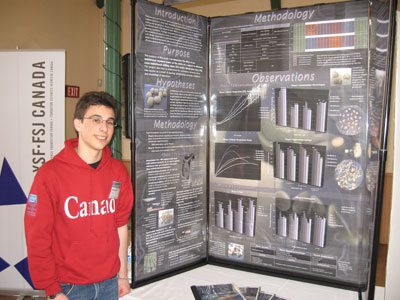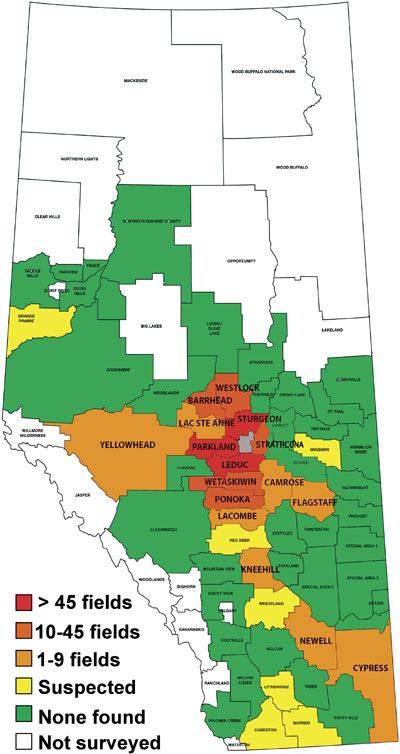
Features
Inoculants
Seed & Chemical
Managing traits in corn
New waves of corn hybrids packed with multiple traits are creating excitement about increased yield potential and improved crop quality in the years ahead.
November 14, 2008 By Blair Andrews
Planting decisions simpler or more complex?

|
|
| Seed companies are working to provide a complete package of traits within a hybrid, including herbicide tolerance and pest resistance. |
New waves of corn hybrids packed with multiple traits are creating excitement about increased yield potential and improved crop quality in the years ahead. The optimism regarding these new hybrids, however, is being tempered by concern that some of the traits, notably those for insect control, may be coming down the pipeline before researchers and growers can get a handle on how to properly manage them.
In recent years, double-stacked, triple-stacked and even quadruple-stacked hybrids have been available in the North American market. And that is only the beginning. Within two years, the major seed companies expect to launch hybrids that will have multiple genes for herbicide tolerance and protection from insects in one seed. While seed industry officials concede that the wealth of traits may lead to confusion and questions about the need to have all these modes of action in one package, they say the end result will make planting corn easier and more convenient. Furthermore, the companies are working toward reducing and even eliminating the need to plant a separate refuge area.
Improvements in crop breeding efficiency and the subsequent new generation of insect protection led to the triple- and quad-stacking of the traits, spawning new names and jargon in the process. These stacked traits from Monsanto are known as YieldGard VT Triple. Bob Thirlwall, a Dekalb field agronomist based in southwestern Ontario, says the VT stands for the Vector stack-Transformation technology. “It’s a more precise process of inserting the genes into the plant,” explains Thirlwall. “We have the Roundup Ready trait and the rootworm trait on the same inbred line, and that is crossed with the YieldGard trait for corn borer to get the VT triple.”
At Syngenta Seeds, a similar line is marketed under the name Agrisure. Dave Townsend, crop manager, says they also launched triple-stacked hybrids that added the corn rootworm trait and combined it with corn borer protection and Liberty Link herbicide tolerance traits. Taking it a step further, Syngenta launched the Agrisure 3000 GT Quad Stack, where AGT refers to glyphosate tolerance. “So it’s a full quad stack,” says Townsend. “Two herbicide traits and two insecticide traits.”
While stacking these traits at different levels may appear to be a game of one-upmanship for the companies, the industry contends that the new hybrids offer convenience, higher quality and increased yield potential. “It simplifies things if guys are growing corn after corn,” notes Thirlwall. “The YieldGard VT triple stack hybrid offers in-plant rootworm protection, as most growers don’t have insecticide boxes on their planters anymore. It’s just a much simpler process of planting; put the seed in the planter and go.”
Thirlwall says Dekalb’s field-scale trials on 22 sites have demonstrated a yield kick from the VT triple-stacked hybrids, even on first-year corn ground. The results showed an average increase of 3.6 bushels per acre on first-year corn ground over the double-stacked hybrids. The VT triple-stacked hybrids also produced a bigger root mass in conditions of drought stress. “So the theory is we can extract moisture from farther out in the soil profile,” adds Thirlwall.
Dave Townsend agrees that the root system is more vigorous, suspecting that the result has more to do with the conversion process than simply adding the rootworm trait. “When we are converting the rootworm trait, we make sure that we select parents that have the same or better roots. The result is the potential for increased yield,” says Townsend.

|
|
| Until technology provides a solution, growers are asked to comply with the sign and maintain their refuge crops. |
Plans are in the works, possibly as early as 2010, to have even more traits working in one seed. Monsanto and Dow AgroSciences have submitted SmartStax for approval in the US. Touted as the first ever eight-gene-stacked combination in corn, the product contains multiple genes that are effective against both lepidopteron and corn rootworm pests, as well as two choices of herbicide tolerance.
In the interest of keeping track, the technologies are outlined as follows:
Dow AgroSciences’ Herculexrm I and Herculex RW technologies; Monsanto’s YieldGard VT Rootworm/RR2™ and YieldGard VT PRO™ technologies; and two weed control systems, Roundup Readyrm and Liberty Linkrm.
The multiple modes of action are designed to control both above and below ground pests, thereby reducing the need to plant refuge acres for pest resistance. Farmers in the northern Corn Belt, including Canada, currently are required to plant a 20 percent refuge of corn that does not use Bt technology near corn acres using the in-plant technology. However, Monsanto has submitted a request for regulatory approval to reduce the refuge requirements for SmartStax, contending that the multiple modes of action decrease the probability that insects will develop resistance to the technology.
If the need for planting a separate refuge can be reduced, what about the possibility of eliminating that step altogether? That is the theory behind Pioneer Hi-Bred’s new insect protection system, Optimumrm AcreMax™. Planned for 2010, pending regulatory approval, the products are described as providing a “built-in” refuge.
The first phase, called Optimum AcreMax 1, will see a combination of a base hybrid with the Herculex XTRA trait and that same base hybrid with the Herculex I trait in the same bag. This approach would reduce the need to plant a separate rootworm refuge.
As soon as 2012, Pioneer could launch the second phase by introducing Optimumrm AcreMax™ 2 insect protection. This next phase combines the YieldGardrm Corn Borer gene with Herculexrm XTRA to provide two modes of action for above ground pests. The addition is aimed at extending the “built-in” refuge strategy to include corn borer and allow growers to meet all of their refuge requirements with a single product (pending regulatory approval). “All of the products that are being developed by the players are designed to reduce the amount of acres that are dedicated to insect sensitive hybrids, and therefore, make the planting of corn acreage for growers that much easier,” says Dave Harwood, technical services manager for Pioneer Hi-Bred, who adds that increased productivity, more convenience and extended durability of the technologies are the most salient points of combining all the corn traits. Harwood also speculates that refuge compliance will improve if the planting process becomes easier. “The approach we have in development will allow growers to plant their entire acreage to an insect-protected product that has built-in refuge, so that the grower can just plant a product on their acreage and, in doing that, satisfy the refuge requirement.”
Harwood concedes that the different approaches of the competing companies may seem strange and confusing. It could also be a point for regulators to consider.
Syngenta plans to enter this game of multiple modes of action with VIP Broad Lep, denoting broad protection against the lepidopteran species. “So combined with the corn borer trait and rootworm trait, it also provides superior control of earworm, armyworm and cutworm, it gets everything except wireworm,” says Dave Townsend.
As he looks ahead to the planting strategies two to three years from now, Townsend says the refuge area for corn borer will likely be reduced to five percent. However, he admits he is nervous about corn rootworm, wondering if two traits will be sufficient. He is also concerned about an overuse of the rootworm trait that could possibly lead to the pest developing a resistance to the technology. “It’s not a high dose trait, and the history of rootworm is that they get resistance so easily.”
Townsend is not alone in expressing concern about the rootworm’s ability to develop resistance. Tracey Baute, field crops entomologist with the Ontario Ministry of Agriculture, Food and Rural Affairs, calls the corn borer traits in the SmartStax awesome, but the ones for rootworm, she says, are not. “The corn borer trait is completely novel from what is already registered and used. And it is high dose,” says Baute, echoing Townsend’s comment. “However, for rootworm it’s different. They are placing the same traits together in the SmartStax that are already registered.”
The fact that rootworm has been exposed previously to these traits actually increases the risk of the pest developing resistance, says Baute. “Given how large a population of rootworm you can have in one field, even if 98 percent are controlled by the traits, the two percent that survive could mean hundreds of individuals emerging.”
Refuge is another issue. Baute says a refuge area needs to be easily accessible to the rootworms because of how little they move around. “By lowering it to five percent, if that is in a block form and at only one end of the field, that five percent is going to be very inaccessible to the rootworm to find and mate with individuals from there,” explains Baute. “And work being done by the scientific community is showing that the ‘refuge in the bag’ may not be the way to go either since they are going to be moving too easily when feeding from a non-Bt plant to a Bt plant, potentially reducing the dose they consume.”
Baute respects that growers want to reduce the refuge size for economic reasons, but she is concerned that the reduction could compromise the long-term sustainability of the technology. She adds that the Canadian Corn Pest Coalition is working on resistance management recommendations for SmartStax in Canada that will be submitted to the Canadian Food Inspection Agency. However, Baute believes much more research needs to be done on rootworm resistance management. “The real issue is that these products are now coming out in the marketplace very quickly before the university and public researchers have time to figure out what the best approach will be for resistance management.”
While the jury is still out on reduced refuges, it appears certain that the triple stacked traits with the multiple modes of action will eventually replace the single and double-stacked traits. Dave Harwood says the move is similar to the way to auto manufacturers offer standard model types and packages. “As things play out, these may be the only product types that we sell,” says Harwood. “We most likely will not offer the non-built-in refuge along with the built-in because that would be more confusing for our customers.”
And once these new seed platforms are in place, even more traits will be built into the corn hybrids of the future. With the goal of increasing production to meet the growing demand for food and fuel, the research pipelines are focused on delivering traits for drought-resistance, nitrogen use efficiency, cold tolerance and end-use traits, such as high-amylase corn, that would help the crop produce more ethanol.
As both excitement and concern greet the new generation of corn hybrids, industry officials are quick to point out that a few foundational aspects will be important in the near term. For one, growers are still being urged to “Respect the Refuge,” and follow the current 20 percent requirements. Bob Thirlwall says this standard procedure has not changed with the introduction of the double-stacked and triple-stacked traits. And while the refuge strategies may change in two or three years, Thirlwall and others agree that the need to select the right hybrids will continue to be a critical decision. “The corn borer trait is a given at this point, growers want corn borer resistance, and we’re finding that over half the growers in eastern Canada are using Roundup Ready as well,” says Thirlwall, noting that hybrid selection comes down to finding the best agronomics, based on soil management practices.